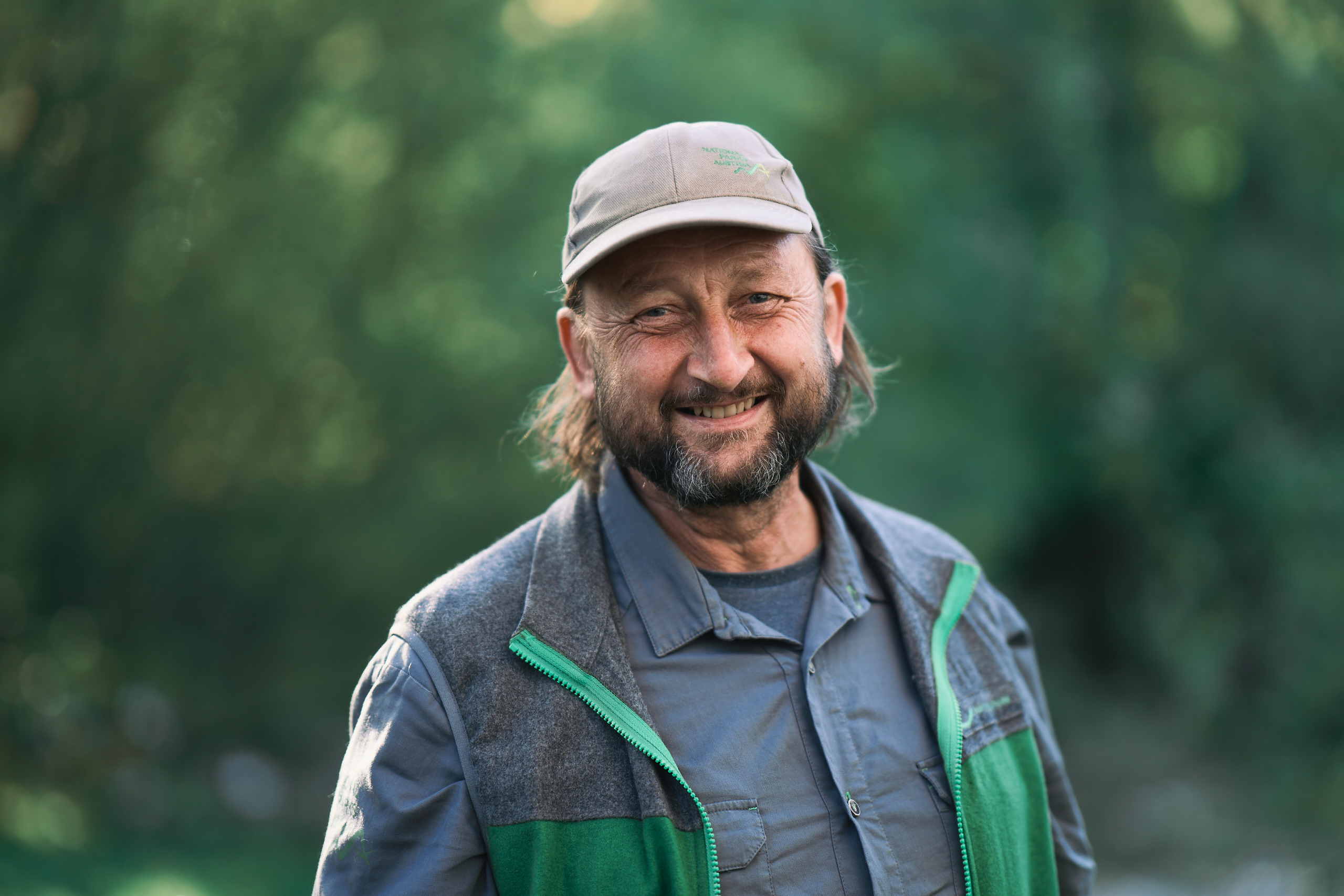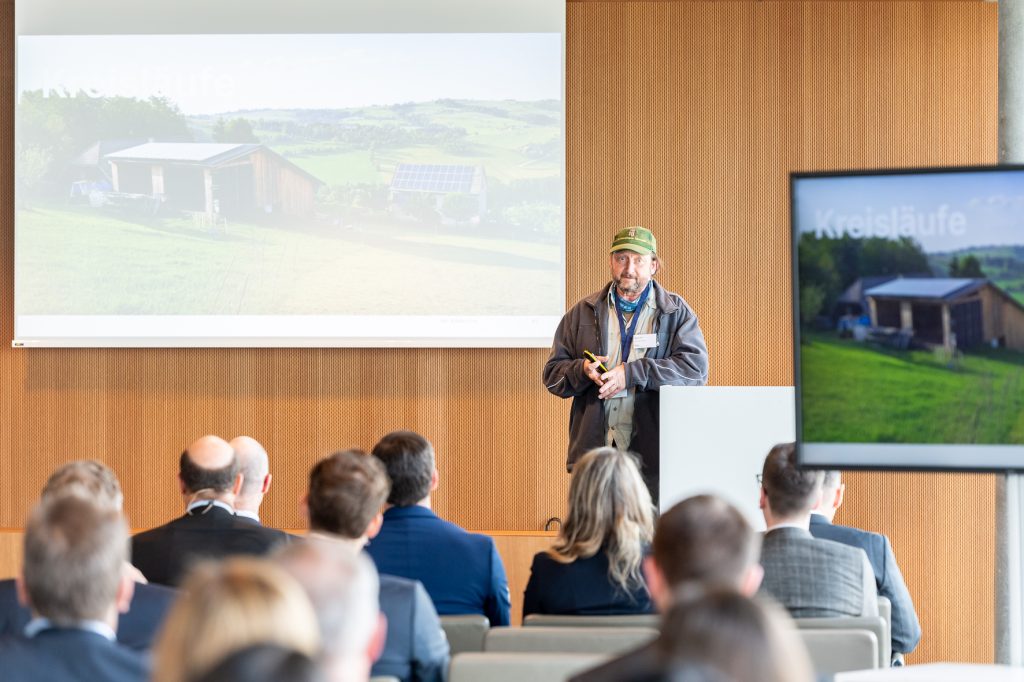Interview with Robert Pröll, farmer & ranger at Kalkalpen National Park (“Limestone Alps National Park”).
The forest ecosystem is not only an important carbon store, but also a habitat for a variety of plants and creatures. In this interview, Robert Pröll, farmer, national park ranger, and speaker at this year’s sustainability conference, explains why we need to protect the “miracle of the forest” more than ever in the fight against the climate crisis.
Your presentation at the sustainability conference is entitled “Wunderwald”, i.e. magical forest. What do you find fascinating about the forest ecosystem?
Robert Pröll: What fascinates me most is that nothing is thrown away in the forest ecosystem. Everything is reused there, whether it’s the dead wood on the ground that stores water or the fallen tree on which new trees grow and thus give new life. Everything runs in a self-regulating cycle. The forest produces a wonderful climate for us. I think everyone knows this: how cool and pleasant the climate is as soon as you enter the forest, while nature outside is overheated.
What motivated you to use your work in the national park to teach people the proper treatment of our forests?
It is important to me that we learn to appreciate our forests and nature in general more again. Only those who appreciate their environment will protect it. As a ranger in the national park, I can explain my ecological concerns to people on our tours. In doing so, children are particularly important to me. Anyone who learns as a child how valuable and important it is to treat nature with care will not forget it as a grown-up. For me, nature-loving children are the conservationists of the future.
Working in the national park is of course only one part of my daily life. I spend most of my time running my small organic farm. Here, it is important to me to go beyond the organic concept. I have always been convinced that our actions must be in alignment with the environment and nature.

About the person
Robert Pröll is a mechanical engineer, environmental technician, European energy manager, skilled agricultural worker, national park ranger and Upper Austrian nature guard. He also runs a very ecologically driven smallholding with an old breed of livestock in Upper Austria.
The climate crisis is omnipresent. How can the forest help us to cope with the effects?
The forest is an enormously important carbon store that breaks down and stores CO2 and can therefore mitigate the greenhouse effect. Many of us only think of the forest in terms of trees and wood growing up into the sky. However, we should not only look upwards, but also downwards. Just to make this clear: a conventional, managed spruce forest covers an area of one hectare and contains around 350m³ of solid cubic metres of wood. Although there are fewer trees in a natural primeval forest, it contains over 1,200m³ of solid cubic metres of wood on the same area – more than three times as much.
What makes the difference is the natural deadwood on the forest floor, which is an enormously important factor, not only as a carbon store, but also as a habitat for many microorganisms. This is exactly why it is important to intervene as little as possible and leave this deadwood in the forest. A degraded and damaged forest floor lacks biodiversity, and it is very difficult to restore it. If we lose natural forests, we also lose a large and important carbon store and thus an ally in the fight against the climate crisis.
What could more sustainable forestry look like?
For a sustainable use, the forest must be managed as ecologically and naturally as possible, and as much deadwood as possible must be left in the forest. We have to move towards establishing more near-natural forests. At the same time, we will also have to accept that we can no longer work as economically as we do now.
What should such an ecological forest look like? Spruce monocultures, as we often find them, are more susceptible to beetle infestation and thus to wind events. You can therefore imagine that such monocultures have little future. It is also important to ensure a high degree of diversity in the structure of the forest and to allow as much nature as possible into the forest and leave it there. However, the top priority should be to ensure that we do not lose any more forests, as we need the biomass and oxygen they provide and cannot do without this carbon store.

Speaking of biodiversity: how clearly do you notice the decline in biodiversity and what problems do you think we are facing?
Biodiversity is being lost at a breath-taking rate. At the same time, in order to adapt to the new conditions brought about by climate change, we need the broadest possible biodiversity. With a broad biodiversity, it is more likely for certain species to be able to adapt to the new conditions and thus help us to cope with the consequences of climate change. However, as biodiversity continues to dwindle at an increasing rate, this is starting to look difficult.
It is therefore important to at least preserve remnant forests from which further development is possible. A case in point: last year, specimens of the red-necked dusky beetle were found in the Kalkalpen National Park. This is one of the rarest beetle species in Europe. In Austria, the last sighting of a specimen was 40 years ago, and the beetle had been lost in the region for 119 years. In the national park we can simply guarantee the conditions to find a large variety of species and that is why such unspoilt areas are so important.
Final question: what can each of us do to contribute to the protection of the forests?
The most important thing that everyone can do to contribute is to understand how important the forest ecosystem is for us and to value it accordingly and treat it carefully. Chipboard, paper – these are things that are destroying our forests. We can consume these things, but we should be careful about how much of them we consume and under what circumstances. A thoughtful approach to this issue is required.
Perhaps a look at the big picture will also help us here: whether it’s the hundreds of years old beech tree in the forest, the little beetle in the leaves, or us humans like you and me – we are all made up of the same building blocks: carbon, hydrogen, magnesium, sulphur, etc. And we all basically run through the same cycle – we are built up and then broken down again, then built up again and then broken down again. So we are, so to speak, built in the same way as nature, which is why we should live in harmony with it.
Thank you very much indeed for the interview!
Info
The Kalkalpen National Park protects the largest contiguous forest area in Austria, covering an area of almost 21,000 hectares. Together with the Dürrenstein Wilderness Area, the national park is Austria’s first UNESCO World Heritage Site.
For more information, please visit https://www.nationalparksaustria.at/en/.
Legal disclaimer
This document is an advertisement. Unless indicated otherwise, source: Erste Asset Management GmbH. The language of communication of the sales offices is German and the languages of communication of the Management Company also include English.
The prospectus for UCITS funds (including any amendments) is prepared and published in accordance with the provisions of the InvFG 2011 as amended. Information for Investors pursuant to § 21 AIFMG is prepared for the alternative investment funds (AIF) administered by Erste Asset Management GmbH pursuant to the provisions of the AIFMG in conjunction with the InvFG 2011.
The currently valid versions of the prospectus, the Information for Investors pursuant to § 21 AIFMG, and the key information document can be found on the website www.erste-am.com under “Mandatory publications” and can be obtained free of charge by interested investors at the offices of the Management Company and at the offices of the depositary bank. The exact date of the most recent publication of the prospectus, the languages in which the key information document is available, and any other locations where the documents can be obtained are indicated on the website www.erste-am.com. A summary of the investor rights is available in German and English on the website www.erste-am.com/investor-rights and can also be obtained from the Management Company.
The Management Company can decide to suspend the provisions it has taken for the sale of unit certificates in other countries in accordance with the regulatory requirements.
Note: You are about to purchase a product that may be difficult to understand. We recommend that you read the indicated fund documents before making an investment decision. In addition to the locations listed above, you can obtain these documents free of charge at the offices of the referring Sparkassen bank and the offices of Erste Bank der oesterreichischen Sparkassen AG. You can also access these documents electronically at www.erste-am.com.
N.B.: The performance scenarios listed in the key information document are based on a calculation method that is specified in an EU regulation. The future market development cannot be accurately predicted. The depicted performance scenarios merely present potential earnings, but are based on the earnings in the recent past. The actual earnings may be lower than indicated. Our analyses and conclusions are general in nature and do not take into account the individual characteristics of our investors in terms of earnings, taxation, experience and knowledge, investment objective, financial position, capacity for loss, and risk tolerance.
Please note: Past performance is not a reliable indicator of the future performance of a fund. Investments in securities entail risks in addition to the opportunities presented here. The value of units and their earnings can rise and fall. Changes in exchange rates can also have a positive or negative effect on the value of an investment. For this reason, you may receive less than your originally invested amount when you redeem your units. Persons who are interested in purchasing units in investment funds are advised to read the current fund prospectus(es) and the Information for Investors pursuant to § 21 AIFMG, especially the risk notices they contain, before making an investment decision. If the fund currency is different than the investor’s home currency, changes in the relevant exchange rate can positively or negatively influence the value of the investment and the amount of the costs associated with the fund in the home currency.
We are not permitted to directly or indirectly offer, sell, transfer, or deliver this financial product to natural or legal persons whose place of residence or domicile is located in a country where this is legally prohibited. In this case, we may not provide any product information, either.
Please consult the corresponding information in the fund prospectus and the Information for Investors pursuant to § 21 AIFMG for restrictions on the sale of the fund to American or Russian citizens.
It is expressly noted that this communication does not provide any investment recommendations, but only expresses our current market assessment. Thus, this communication is not a substitute for investment advice, does not take into account the legal regulations aimed at promoting the independence of financial analyses, and is not subject to a prohibition on trading following the distribution of financial analyses.
This document does not represent a sales activity of the Management Company and therefore may not be construed as an offer for the purchase or sale of financial or investment instruments.
Erste Asset Management GmbH is affiliated with the referring Sparkassen banks and Erste Bank.
Please also read the “Information about us and our securities services” published by your bank.
Subject to misprints and errors.



